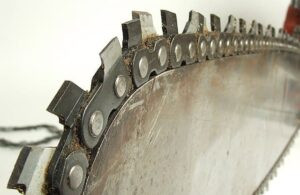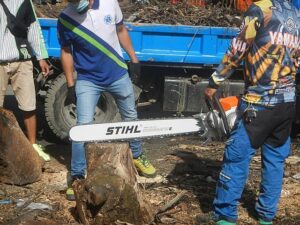As an Amazon Associate, this site earns commissions from qualifying purchases. For more information click here.
It takes more than a full tank and a sharp chain for a chainsaw to work. The bar must also be in good condition. Without the bar the chain is useless so knowing how long it lasts is crucial. Just like with the chain, there are many factors that determine the lifespan of a bar.
The general rule is to replace the chainsaw bar once you have gone through three chains, but some bars can last up to ten years. Bars are usable as long as it is not bent and there is no damage to the nose sprocket or the track.
When Should You Replace a Chainsaw Bar?
Chainsaw bars can suffer all kinds of damage, but the most common are bending, a worn out sprocket, the rail gets pinched or the bar track is worn out.
Bar is Bent Already
Longtime chainsaw users can quickly see a bent bar. If your cuts always veer to one side that is a sure sign. If this happens, turn your chainsaw off and remove the bar. Put it on a table and you should be able to tell that it is bent.
Never use a bent bar. It is potentially dangerous as the chain could come off anytime. Usually a bar bends slowly, but if yours suddenly bends when you use it, turn the chainsaw off immediately.
The most practical solution is to buy a new bar. You could try and straighten it by pounding the bent part, but you risk breaking it. It is easier to just install a new one. If you do not replace it, the chains could come loose and make cutting impossible.
If you use a Husqvarna chainsaw, the Husqvarna Genuine 596689172 20 inch bar is the ideal choice. It is made by Husqvarna so you can be sure it is compatible with their chainsaws.

Pinched or Cracked Rails
Pinches and grooves often appear when you try to cut dense wood and the chainsaw gets jammed. A chainsaw bar can develop cracks or tears from prolonged use. Cracks will get bigger over time so replace the bar.
Needless to say, you should never use a cracked chainsaw bar. Even though it might be small, it could widen as you use it. The last thing you want is for the crack to get big enough to make the cutter unstable while you are using it. In this case, replacing it is the best option.
Worn Out Bar Track
If the chain becomes unstable, it is probably due to a worn out bar track. Even a well-made bar will get worn out after prolonged use.
Aside from a loose chain, the measurements will show the bar track has gotten too wide or too low. To make sure, measure the bar and compare it with the official measurement in the product manual. The discrepancy will prove the bar track is worn out.
Bar Sprocket Nose Damage
Damage to the bar nose usually occurs when you cut frequently towards it. Over time this cause the bar to deform. The sprocket makes it possible for the chain to move along the bar so it is an integral component of a chainsaw.
If the nose is damaged, you can either replace the entire bar or the sprocket only. Check your manual for information on how it is replaced.
How to Replace a Chainsaw Bar
At some point you will have to replace the chainsaw bar. Usually the bar is replaced after three chainsaw chains have been used. However you should get a new bar if it is damaged.
Step 1. Take note of the bar size. The replacement has to have the same specifications. Wear gloves. Turn the chainsaw off and hold it so the bar faces away from you.
Step 2. Take the chain cover off. Remove the nuts on the sprocket. Check your chainsaw operating manual for the required socket size. Once the nuts are unfastened, you may take the bar off.
Step 3. Now you have to lessen the chain tension. To do this, push the bar back a bit. Pull the chain off now that it is loose.
Step 4. Pull the bar out. Take this time to clean the sprocket, its cover and the area around it.
Step 5. Take your new chainsaw bar and set it onto the adjustment posts. Make sure the bar is secure before you put the chain back. Adjust the chain so it is properly set against the sprocket.
Note: the sharp end of the chain has to point at the front end of your new bar. Adjust the chain so it is properly positioned on the rails.
Step 6. Hold the bar and pull forward to generate chain tension. You have to fine tune this but there are a few things you have to do first.
Step 7. Put the cover on. Place the nuts on the adjustment posts but not too tightly.
Step 8. To adjust the chain tension, look for the adjustment chain screw. On some models you can find this on the sprocket cover. When you are done, tighten the sprocket nuts.
With other chainsaws, the chain adjuster is located on either side of the adjustment posts. Keep the sprocket nuts loose while you are fine tuning the chain tension.
Adjust the chain carefully to avoid damaging the bar. When you pull the chain drivers from the bottom and they do not come off the rails, it is tight enough
Step 9. Once the chain is set, fill the bar oil. Put some of that bar oil into the nose sprocket too. There is an opening where you can pour the oil.
When everything is set, turn the chainsaw back on. Let it idle for a minute or so then give it a try. It should run like new.
Chainsaw Bar Maintenance Guide
The best way to extend the life of a chainsaw bar is proper maintenance. By following these simple steps you can make the bar last longer and be more productive.
Always Use Bar and Chain Oil
Applying bar and chain oil is the simplest, most effective way to prolong the life of a chainsaw bar. Our pick is the Echo 64590007 Bar Oil as it works with all chainsaws, and a little goes a long way.
Additional heat damage comes in the form of track burns along the edge. By using bar and chain oil regularly you can prevent this from happening.
How often should you run it with bar and chain oil? Every time you fill the fuel tank or finish a wood cutting session, inspect the bar and chain oil. Add more if required.
Running your chainsaw without bar lubrication makes it vulnerable to overheating. If the blade gets hot it could cause serious damage. if the chainsaw gets wet it is a different matter.
Clean the Bar Track
This might be stating the obvious, but removing dirt, dust and other debris on the bar track helps. The cleaner the bar, the less friction when you cut.
Make it a habit to clean your chainsaw regularly. Usually after heavy work we take out the chain and bar for cleaning and inspection. Take this time to clean the bar track.
Take your gauge utility device, set in the bar track and remove the dirt. Clean the rest of the chainsaw including the oil aperture so the oil gets through.
Flip the Bar
It is a good idea to flip the bar after every cleanup. Why would you do this? Because it distributes wear and tear uniformly.
The part that gets worn out first is the bottom. By flipping the bar you ensure the wear is evenly spread out. If one part is more worn out than the other, the cuts will be uneven.
Never Use a Dull Chain
You need a sharp chain to cut dense green wood. Putting more pressure on the bar is not going to help. If the chain is sharp enough the blade will cut through it. If you have to exert a lot of force, the chain is too dull.
Chainsaw chains ca n last for years if well maintained. However you should sharpen or replace it as soon as its teeth start to dull because it will put more pressure on the bar.
You can sharpen a chain several times before it has to be replaced. Look for the sharpening mark, a small line on the metal. As you sharpen the chain, bits of metal is shaved off. When it reaches the mark, replace the chain.
File the Bar Track
As you use a chainsaw, bumps or spurs will eventually appear on the bar track. Also called spurs, these are signs the bar is getting worn out. The easiest way to get rid of metal spurs on the chainsaw bar is to use a hand file. File the sides and you will get rid of the bumps easily.

I love the outdoors and all the tools for maintaining gardens, yards and lawns. The only thing I am more passionate about is sharing what I know about garden and outdoor equipment.


